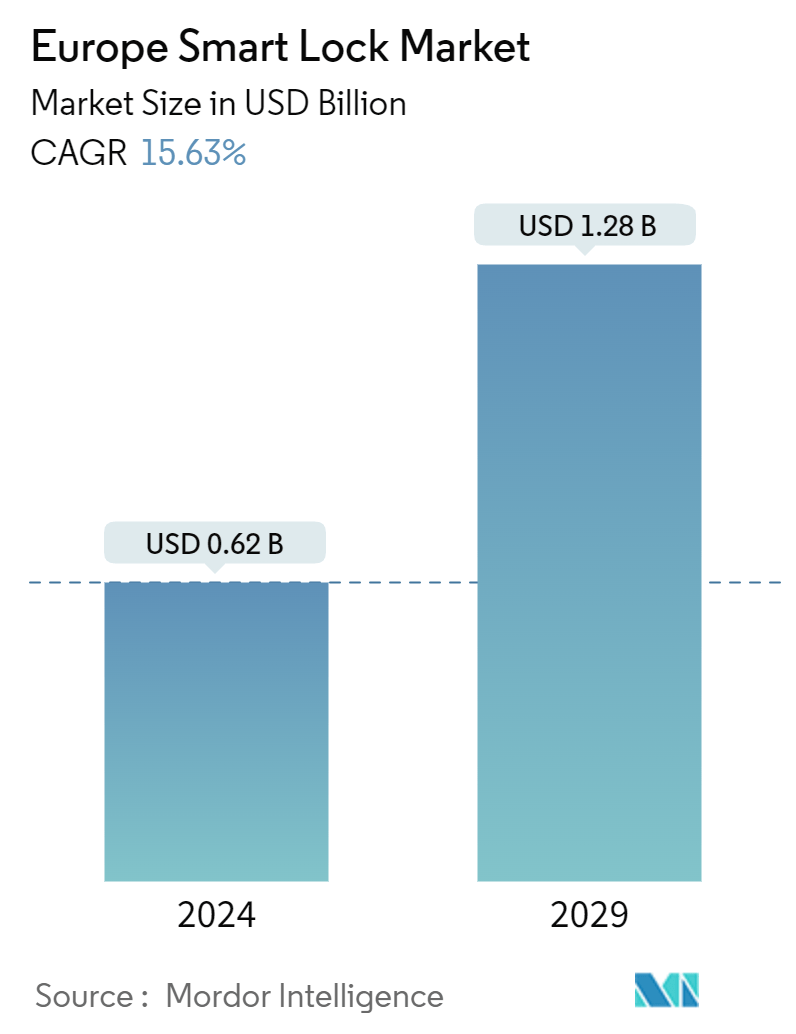
| Study Period | 2019 - 2029 |
| Base Year For Estimation | 2023 |
| Forecast Data Period | 2024 - 2029 |
| Market Size (2024) | USD 0.62 Billion |
| Market Size (2029) | USD 1.28 Billion |
| CAGR (2024 - 2029) | 15.63 % |
| Market Concentration | Medium |
Major Players
*Disclaimer: Major Players sorted in no particular order |
Europe Smart Lock Market Analysis
The Europe Smart Lock Market size is estimated at USD 0.62 billion in 2024, and is expected to reach USD 1.28 billion by 2029, growing at a CAGR of 15.63% during the forecast period (2024-2029).
- In Europe, the demand for smart home devices, particularly smart locks, is on the rise, fueled by the increasing embrace of smart home technology. As Europeans show heightened interest in home automation, the demand for smart locks, especially those that seamlessly integrate with other smart devices, is surging. With a growing number of renovation projects and a heightened consumer appetite for smart home solutions, the demand for these products is set to rise. Furthermore, the robust purchasing power of consumers, combined with the need for modern security features like remote-controlled door locks, motion sensors, and window and door sensors, positions the market for continued growth during the forecast period.
- As smartphone penetration rises, so does the growth of connected devices. This trend allows users to remotely access and control their door locks through dedicated mobile apps. GSMA reports that with mobile penetration hitting 90% across Europe, the mobile ecosystem is set to focus on boosting 5G coverage in rural areas. This push comes with heightened investments to broaden the adoption of use cases enabled by both 5G standalone and 5G advanced technologies. Projections for 2030 suggest Europe will have 507 million unique mobile subscribers, translating to a 92% penetration rate.
- Furthermore, digital technologies are rapidly advancing, driving the growth of the smart lock market in Europe. The region's robust manufacturing sector is adopting cutting-edge technologies like the Internet of Things (IoT), the Industrial Internet of Things (IIoT), and Industry 4.0. As a result, top global companies are forming partnerships with European firms, leveraging the region's established infrastructure. In March 2023, iLOQ, a Finnish company in smart locking and secure access solutions for buildings, signed a supply agreement with Honeywell Building Technologies. Under this deal, Honeywell pledged to source access management solutions directly from iLOQ.
- Smart locks, boasting advanced features and technologies, typically command a premium price over traditional mechanical locks. Features such as Bluetooth or Wi-Fi connectivity, biometric authentication, mobile app integration, and remote access capabilities contribute significantly to this elevated cost. Such premium pricing challenges budget-conscious European consumers, particularly during economically tough times. Beyond the cost of the lock hardware, professional installation is often necessary for smart locks, further inflating upfront expenses. Integrating a smart lock with pre-existing home automation systems or electrical wiring can complicate the installation, driving up costs. As a result, these installation expenses may deter European consumers, who often lean toward more DIY-friendly and budget-conscious solutions.
- Macroeconomic factors such as housing starts, new home sales, and home prices in the European housing market may significantly influence the demand for smart locks. Eurostat reports that in Q4 2023, residential real estate prices rose across most EU countries, with Poland, Bulgaria, and Croatia witnessing the steepest increases. Robust conditions in the housing market, marked by a surge in new home constructions and sales, pave the way for greater integration of smart locks during initial home setups.


